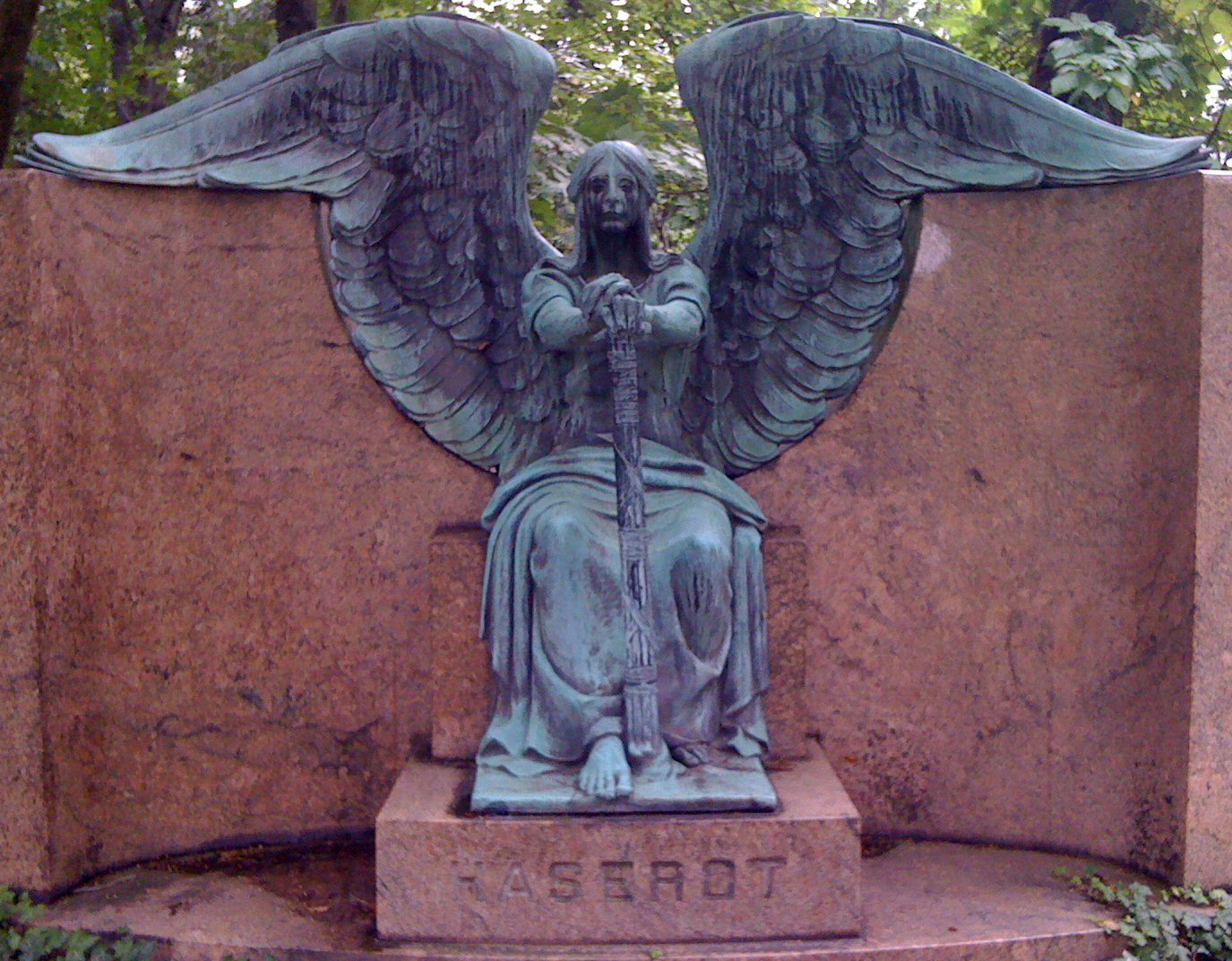So What’s It Like To Eat At A Two-Michelin-Starred Restaurant? A (Long) Review of Sixteen
If you’ll recall, my wife and I got drunk on a heady mixture of MasterChef and the Food Network, and decided to dine at Michelin-starred restaurants this year. A Michelin Star is like every other award in existence – which is to say that it claims to reward “the best,” while covertly defining “the best” to be a narrow range of tastes. (If “the best” movies are Oscar winners, then comedies and horror movies apparently suck.)
Michelin defines “the best” to be expensive, hard-to-prepare food with attention to detail and impeccable service. Which generally implies pretty good food, but it leaves out, you know, that clam shack down at the beach that serves perfectly-steamed mussels taken straight from the ocean. Yet still, when we dined at Babbo (one star), it was still one of our top ten restaurant experiences ever, and La Terrazza del’Eden in Rome was also very good, so…
…we had to upgrade. Enough with these paltry one-star restaurants. Let’s see what two Michelin stars gets us! And so we booked a meal at Sixteen in Chicago.
Now I will walk you through our meal, which was overwhelming on every level. Thirteen courses of food.
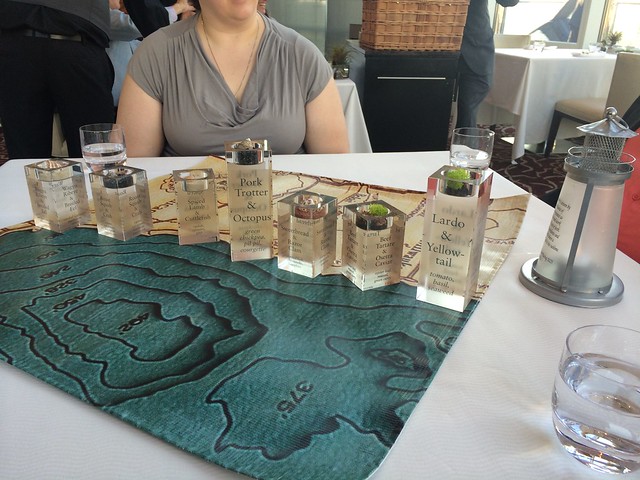
Sixteen clearly set out to dazzle from moment one, wherein they laid out a map of Chicago’s waterfront and laid out the menu in little plastic blocks. The menu, which changes seasonally, is a very upscale version of surf and turf, and each course was a melding of seafood and the meat district that Upton Sinclair helped make famous. This was all to hide the reality that when you came to Sixteen, you ate what the chef damn well felt like making from you, but it did lend a festive Lego-style atmosphere to the dining.
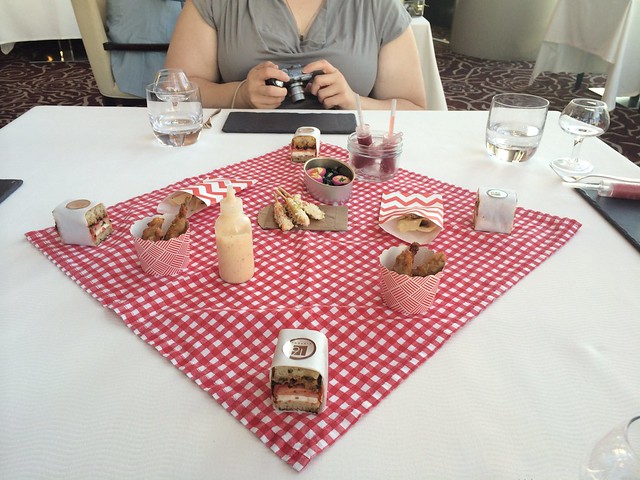
Now, the surprise appetizer course was utterly adorable, in that they said, “We’re at the beach now, so we’re having a picnic” and laid out all sorts of little picnic foods for us. This was a great start, because every mini-food on here was quite above the cut:
- The mini-sandwich was tomato, Italian ham, and mozzarella, if I recall, and it was perfect. Every bite brought out the tomato and the meat and the cheese and the toasted bread in a different combination, a little tooth-inspired dance of flavors and textures interplaying with each other, so this was good right up through the last swallow.
- The quail legs were dark meat, and I usually don’t like dark meat because it’s monotone and oily… but this was firm, cooked well, and seasoned so that it had a wonderful texture between the crispy skin and the salted meat.
- The potato chip had a tiny piece of smelt actually woven into the chip, which was a piece of starchy sewing that we could only admire, and what that got us was a slightly soggy potato chip that melded quite nicely with the salty fish taste of the smelt, so what you got was kind of a crunchy fish with a sharp burst of salt around the edges. Awesome.
- Finally, there were sangria popsicles. Which were the disappointment. They weren’t like sorbet, as we’d expected, but rather creamy, which I suspect was some sort of chemical adhesion so they didn’t melt instantly while we were eating sandwiches. But the cream in the center completely obliterated any sangria flavor – if you hadn’t told me, “Hey, this is supposed to be sangria,” I would have thought it to be some sort of bland fruit pop. Still fun, but meh.
This came with a tiny glass of sweet peach tea and whiskey, and boy did that work well. The only complaint I had about that drink was the glass was very small.
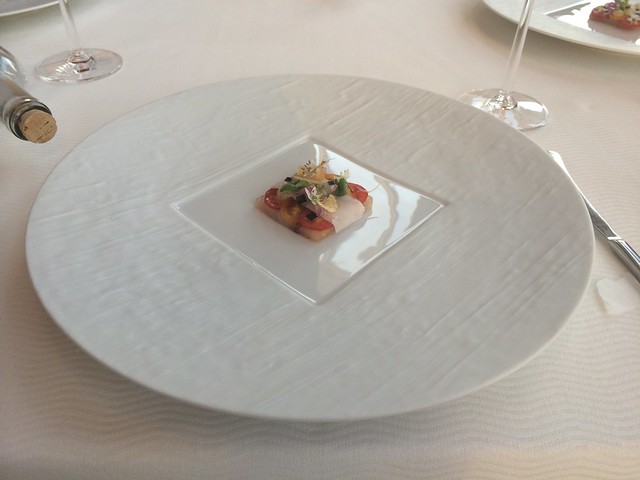
Official Course #1 was a lardo and yellowtail ceviche, with tomatoes, basil, and seaweed. It was, like the sandwich, a really good mixture of flavors and textures – every bite mushed around the lardo and the fish and the tomatoes in your mouth, bringing out a different combination, allowing you to savor them in different ways. There was also a fried pork with tuna on the side, which literally melted in your mouth, the delicate cracklings softening into the tuna flavor in a way that really worked well.
It was at this point that Jeremiah said, “I can’t remember what lardo is,” and we discussed it for a bit, and the waiter by the table had that “Oooh! Oooh! Pick me!” look that only a fifth grader in a busy class gets when he’s hoping for the teacher to call upon him. But interrupting our discussion would have been rude, so he just sort of bit his tongue until we asked him.

Course #2 was “The Luxury Course,” which was a small dollop of beef tartare surrounded by Osetra caviar – and yes, that’s gold leaf on the salad around it.
This one was fascinating, as I alternately loved and loathed it with each bite. The first bite was a beautiful meld of rich beef flavor and complex caviar fishiness – and then the next was this salty, bottom-feeder muck of Too Much Caviar and mushy beef. Another bite, it was wonderful. Next bite, it was awful. I eventually decided I liked it, but it was a rollercoaster of a dish where I still am undecided on whether beef tartare and caviar is a good idea.
The salad was, well, a salad. It was hard to get onto the fork (look at those long leaves, and imagine trying to balance them all), and it didn’t particularly blend well. Eating it was, “Oh, hey, a leaf! A mussel! A crunchy thing!” And they didn’t gel.
On the plus side, if you eat gold leaf, your crap is greenish the next day. Now that’s something most reviews won’t tell you.
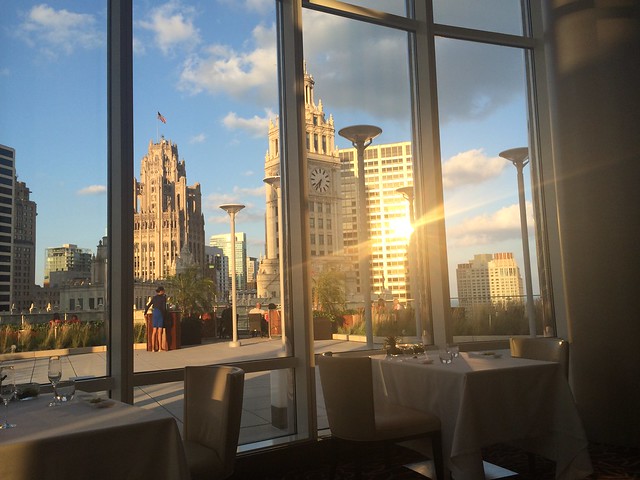
I took this moment to snap a view of what the restaurant looked like from here, feeling quite decadent.
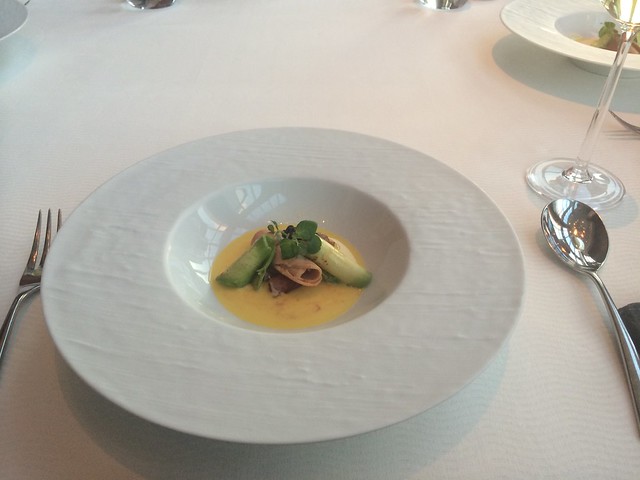
Course #3: Ahi tuna and foie gras in a broth of sweet corn and honey. The broth was the star here, as it was possessed of the kind of subtle flavors you have to strain to pick out, this ephemeral blend of corn taste suffused with the barley overtones of honey, where we could have drunk just that. The tuna and foie gras were both good, but they didn’t seem notably transformed by the broth – when you ate one, your mouth went, “Hey, it’s tuna!” and it completely overshadowed the delicate broth taste, and of course foie gras (being more intense in general) obliterated it.
The avocado worked well with it. But there was only a little snippet of avocado.

Course #4: Sweetbread and razor clam in a charred leek with a sweet sauce. The sweetbread was, hands-down, the best sweetbread I’d ever had – the kind of dish that informs all future dishes. I’ve found that a good example of a food I normally dislike can completely turn my opinion around on it, as I’ll go “Oh, that’s how it’s supposed to taste,” and now that I know what people like about it, I will notice that part so much more in lesser versions of that food that my whole expectations turn around.
Anyway, most sweetbreads I’ve had (even at Lola’s, Michael Symon’s carnetarian restaurant) tend to be pasty-greasy, an unpleasant napalm-like smear of mush held together by a slight metal-and-bile taste. But this was rich, bacony to start, descending into a firm texture that was unique to sweetbreads. A delight.
The leek was… well, less successful. They told you to eat everything but the charred parts, and indeed if you could get the tender bits of the leek you’d find it soaked in a delicious sauce. But the leek was firm, like celery, and resisted being pulled apart with a fork, and they had provided no knife to cut through the rubbery leek surface. We tried our best to separate it out with the edge of a spoon, but really, if you wanted us to eat it then you should have given us the proper implements to do so.
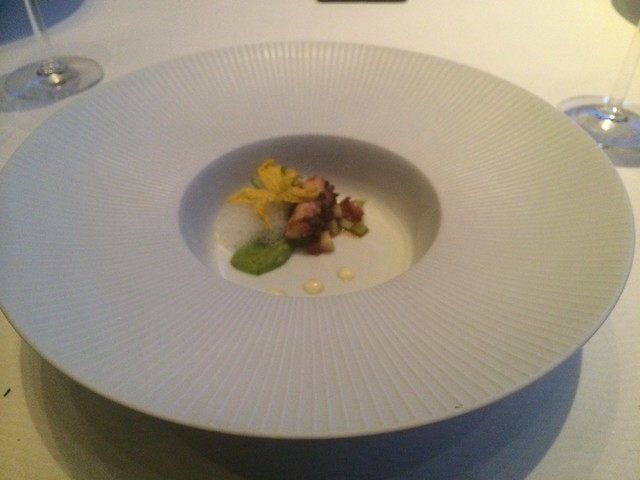
Course #5: Pork trotter and octopus, with almond foam and pil pil sauce.
…we were quite disappointed that they didn’t call this “porktopus.”
That said, the mixture of pork and octopus was neither a failure nor a success. It was well-cooked, but it tasted more like chewy pork than some great melding of the two, and the almond foam (while tasty) seemed sort of standing wanly out in left field, yelling “I’M TASTY!” and with all of us going, “Yes, but what do you go with?”
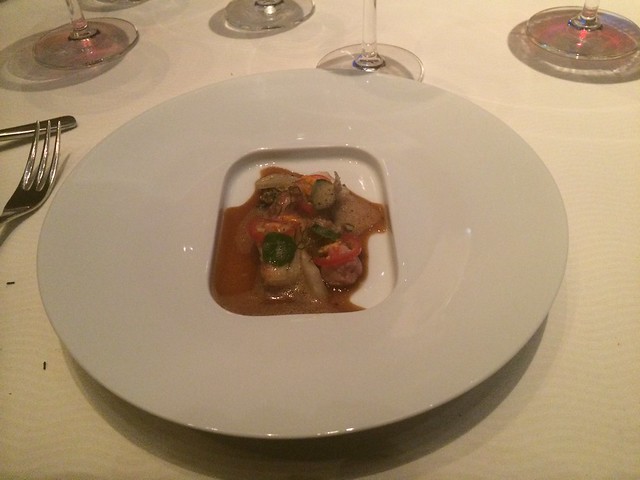
Course #6: Chicken oyster and langoustine in a nasturtium sauce. This is where we breathed a sigh of relief, because frankly, this dish was a disappointment. And we wanted a disappointment, really. Well, okay, we didn’t, but the danger of us going, “Hey, we are paying basically a mortgage payment to sit here, so we’re just going to assume that everything we’re given is super-awesome, having our tastebuds overridden by the gigantic wads of cash we’re forking out,” and to say, “This is actually kinda meh” was a relief. It was proof to us that we weren’t just surfing on a tide of snobbery, that indeed we retained our common sense, and this wasn’t terrible but both the chicken oysters and the langoustine were bland meats and the sauce wasn’t enough to make them interesting.

Course #7: Spiced lamb pho-style broth in cuttlefish noodle. The broth on this was insanely tasty – this light complex bubbling of flavor with hints of all sorts of complexities, like a good pho broth should be. But we were glad that they termed this a pho-“style” broth, as both Jeremiah and I admitted we’d had better pho – as pho is supposed to be full of Stuff, and this plate had three dabs of lamb and a palmful of cuttlefish noodles, so what you got mainly was awesome broth. Head to head with pho, this loses, but it cleverly marked out its own space as an “interpretation” and so hey, we were cool.
Also, the lamb was pretty much irrelevant here – it could have been any rare kind of meat, as it was completely overridden by the taste of the broth. But since, as noted, the broth was genius, who cares?
Also to the also, this was by far my favorite plate of the whole meal. Look at how awesome this plate is. It’s like a Hotblack Desiato plate.
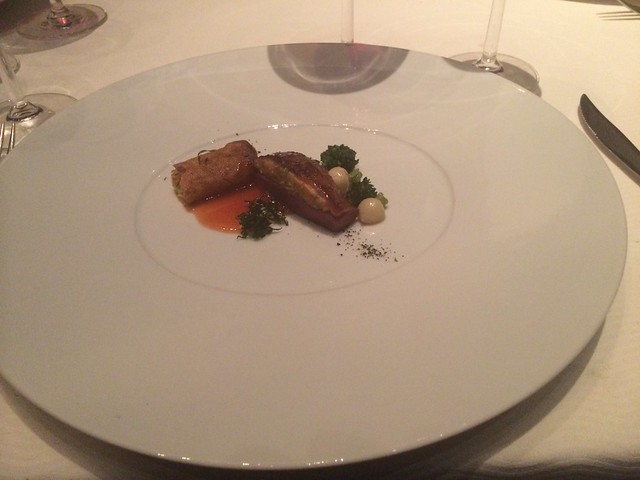
Course #8: Roast squab and crab and lo, we have hit the nadir of the meal. The crab was just crab, not seasoned or made interesting in any way, and multiple people came to the conclusion that the sauce here was basically like the sweet-and-sour sauce you get in a grocery store’s Chinese food salad tray. The squab was slightly better, but really, this dish wasn’t something I’d have paid $10 for, let alone Sixteen-style rates.
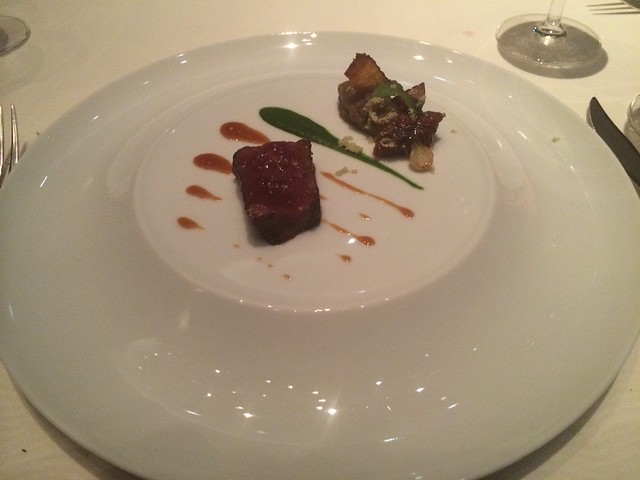
Course #9: Wagyu ribeye and broiled eel with smoked eggplant puree. And we rebounded up to one of the highlights of the meal, thankfully, as it’s hard to make Wagyu ribeye bad (especially in small as portions as this). But the eel was the revelation for me, as I usually don’t like fishy-tasting foods, and this eel was very smoky-sweet, almost candied, like a sweet barbecue sauce – it still tasted like fish towards the end, but the combination of fish and a sugary pop made it a really complex and new interplay to me. This was definitely a moment of “Oh, here’s why some people like eel!” and the idea of eel as dessert suddenly made sense.
The pureed eggplant was very good as well, having a little bitterness of the eggplant melding with the smoky flavor, working quite nicely in conjunction with the eel.
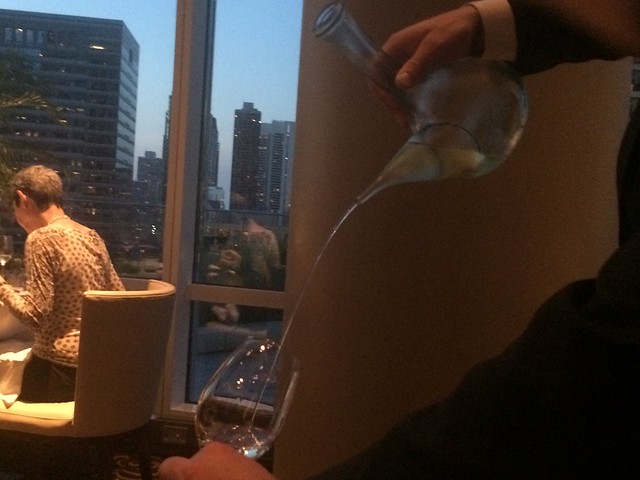
A word on the sommelier: I haven’t discussed the wines, as I’m not a wine person, but I didn’t think a lot of the choices we got particularly matched well. I think, if I had to sum it up, the sommelier prioritized “interesting” over “flavorful,” as we got fortified wine with one course that did not go, we got a very mineralish white that, when combined with the salt of the meal, turned almost to brine in our mouths, and we got a very nice Sake to go with the pho that pretty much stomped all over the delicate taste of the pho. Some of the choices were good, but mostly it seemed like a serious case of “See how clever I am?” and not a contemplative pairing to our table.
There was, however, a wine pairing that was $750 per person, where each glass would be drawn out of the bottle and the air inside the bottle replaced with nonreactive argon, so they could give you super-rare wines. I was very curious, but not $750 per person curious.
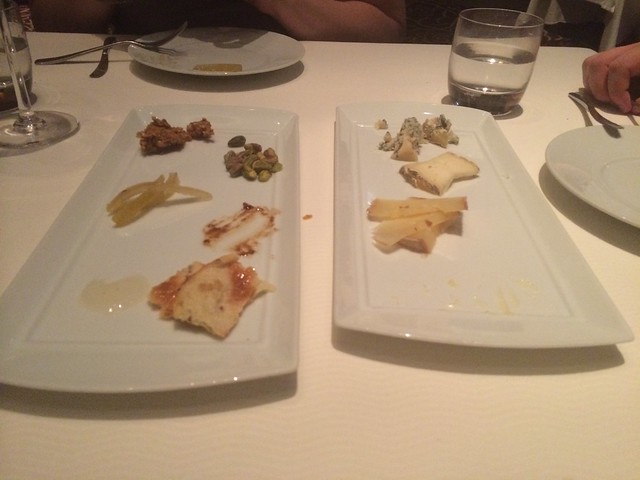
The cheese course was optional, but even though we were stuffed of course we were having the cheese course. Because hey, cheese. And we got some very nice and funky cheeses, which weren’t listed on the booklet (more on that later) so I can’t tell you what they were beyond a nice slice of perfect crystallized bleu cheese.
We also may have, uh, eaten one cheese before taking a picture here. Our bad.
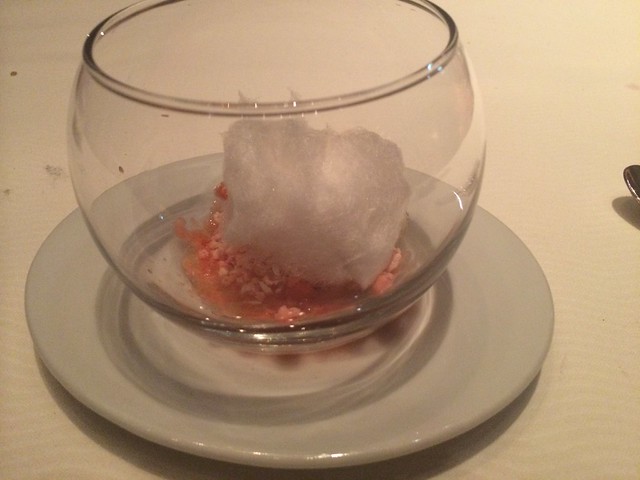
The Gift Course: in between the two desserts was a “gift” course to cleanse our palate, which was a nice switch-up on the usual dollop of sherbert served at upscale and/or stuffy restaurants to give you a bridge between the savory of the meal and the sweetness of the dessert. This was a particularly neat variant – a clump of cotton candy in a strawberry condensation with black pepper and thai basil that you were expected to stir until it was all one sweet mess.
This was intensely fruity, just three spoonfuls by the time everything was done – sherbet-like, but more satisfying because you had to put the work into it.
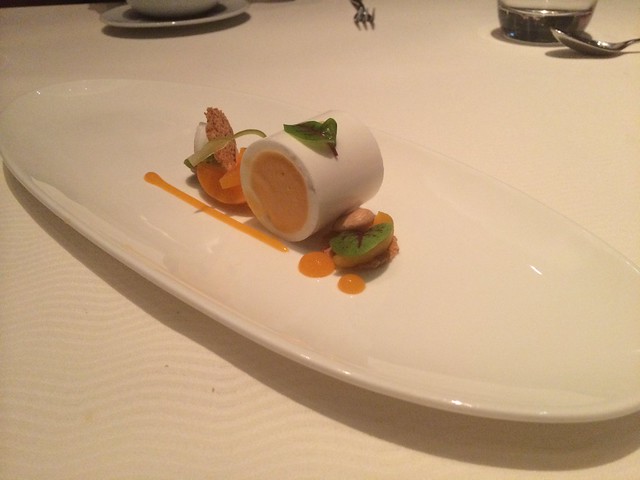
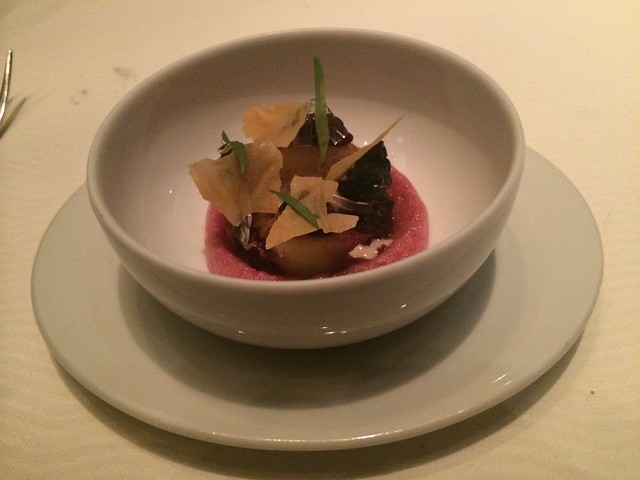
Dessert Course #1: Land and sea. The land portion (the fruitier one) was an apricot-and-almond mixture wrapped in an unreal bit of meringue that looked absolutely like a ceramic sculpture. I’ve never seen meringue that smooth. It was unearthly, and Gini ate it up. My dish, however – a blackberry dish – was less successful, being a clump of miscellaneous flavors with no real center to it. Every bite was different, as in past courses above, but sadly every bite was different in the “Oh, here’s some different ingredients” way, not the “This is bringing out new flavors in old ingredients” way.

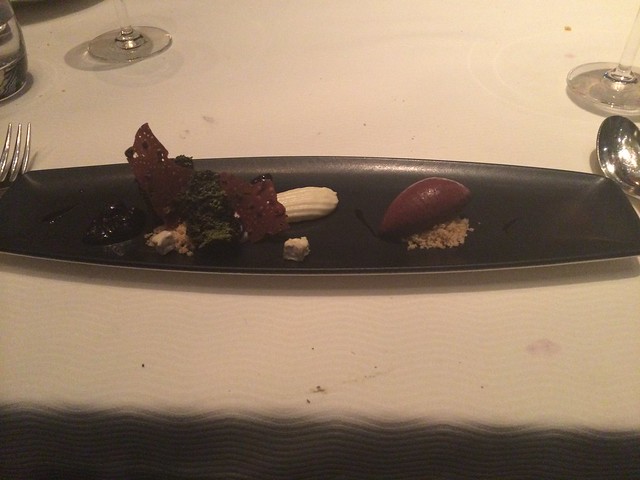
Dessert Course #2: Land and sea, part 2. Gini got a blueberry, corn, anise, and hyssop which looked like a hot mess and again, was a nice bunch of flavors but not particularly cohesive. Mine was slightly better, with smears of goat cheese and chocolate and crumbly cake, but it seemed like “random chocolate stuff” and hence didn’t work for me as a whole.
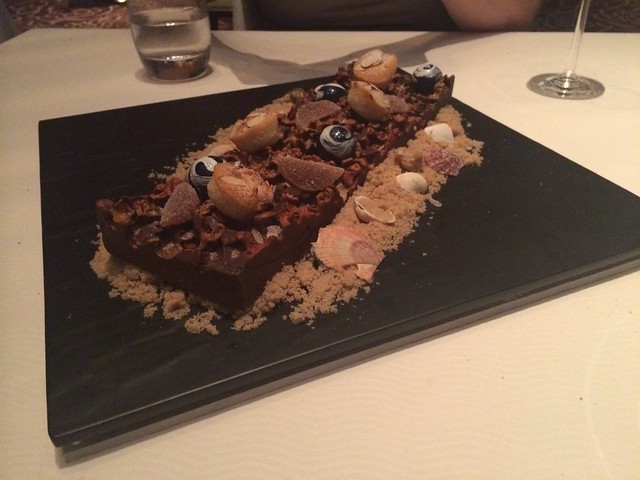
The finale surprise: As the bill came, we got this, which was… baffling. It had four chocolates and some candied fruit on it, but you’d think the bulk of this would be edible. It looked like chocolate. It was, I think, wax. And it came drenched in brown sugar, which was nice, but then had actual shells in the “sand” – and I remembered Gordon Ramsay screaming, “Never put anything on the plate that they’re not supposed to eat!” We even tasted the shells, befuddled. (Or at least I did.) It was nice, but we spent too much time going, “What is that thing?” and not enough time eating.

We finished up getting a take-home bag that, in social media-friendly style, listed all the ingredients and preparations for the all the courses, so we could, you know, review them at length in our blog. Smart move, Sixteen. (Also a couple of chocolate pops for later.)
So Was It Worth It?
Look, Sixteen was worth a mortgage payment and then some. We’ll be paying for this sucker for some time.
The relevant questions are: a) was it the best meal we ever had? and b) was it significantly better than the one Michelin star meal we had?
The answer as to the Michelin star question is unquestionably no. When you’re paying as much as a used car to get your meal, you want flawless service, and there were a couple of significant bobbles – the wrong foods being given to the wrong people, the forgetting of a drink, and unforgivably, giving us the wrong check.
It is very hard to be moral when someone gives you a check that is worth several hundred less than you actually owe. It’s even harder when they go “Whoops, our bad” and bring you the full check, with nothing written off on it, no discount for this honesty. Hey, the cheese tray was $35, you coulda given that to us for free and we would have felt moral and frugal. As it was, I don’t exactly mind paying full price, but the restaurant really hit home just how much this cost, leaving a tremendously sour taste on the way out the door.
But that aside, I was of two minds: I personally don’t mind a bobbled check, or having to switch plates with my wife when the wrong dessert arrives. But when I’m paying premium price for what is, literally, world-class service, getting elementary mistakes becomes a weird question: Should I let this slide? I mean, I could buy a large portion of a woodworking workshop for what I paid for this meal, and part of that cost was the promised flawless service. And what I got was very good in many ways, but world-class?
No.
Now, it could be that Sixteen no longer deserves its two-star rating, and we’ll see them slide down to one star next year. (Ratings are dynamic things, you see.) It could be that they had a bad night. Either way, though, I paid about $200 above what I paid for Babbo, and Babbo was not exactly cheap.
As for the food, Gini rates it the best meal she’s ever had. Me, I’d rank two above it: Victoria and Albert’s in Disneyworld, and Babbo in New York City. This was a very good experience, don’t get me wrong, but I don’t know if Michelin was correct on this one. There’s also the fact that, frankly, both Victoria and Albert’s and Babbo tend to be conservative in their meal choices, whereas obviously Sixteen had some playful experiments that were aiming higher and fell harder. (Agnolotti is hard to do, but you have a clear idea of what the perfected state of it should be; more difficult to find the perfect porktopus.)
So I liked it. Very much. But the expense really carved the edge off. Were this the same price as a Babbo meal, well, I woulda said this kicked the crap out of Babbo. But value enters into the equation, and with that much on the line, well, I’d probably go with Babbo again.
Still very good. Memorable. Awesome. But spendy. Let’s see how other restaurants compare, once we’ve grown back our meager savings.
Oh, as an extra bonus, here’s how I looked in The Suit that day:

